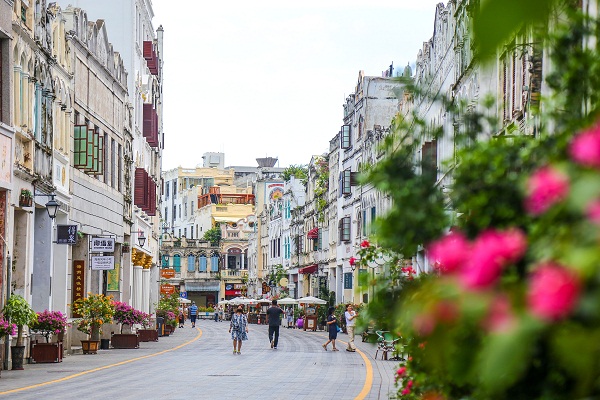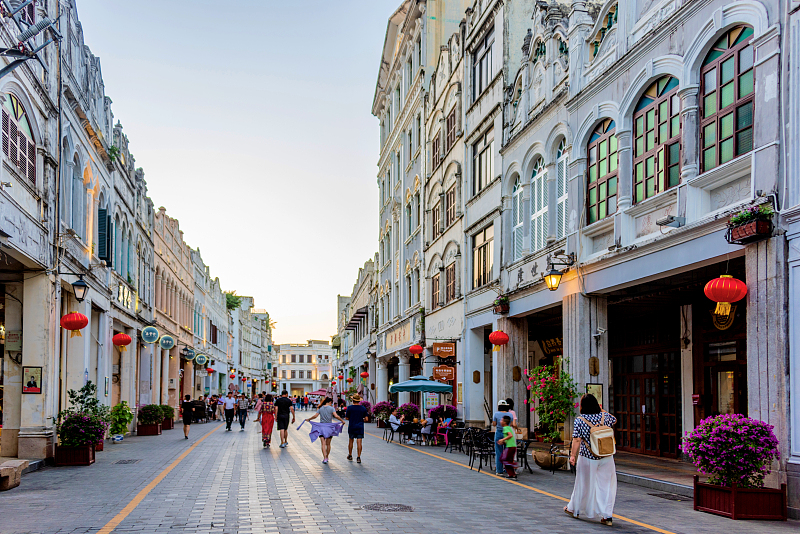Discovering Haikou’s Qilou Old Street and Hainan Culture
Imagine strolling through a vibrant street where history whispers from every corner, blending ancient traditions with modern flair. That’s the magic of Haikou Qilou Street, a captivating gem in Hainan’s capital city. As a hub of Haikou cultural heritage, this area offers a window into China Hainan culture, showcasing the island’s unique fusion of Eastern and Western influences. Whether you’re a curious traveler seeking cultural attractions in Haikou or following a Haikou travel guide for an authentic China history travel experience, this destination promises unforgettable insights. Here at jusha.travel, we love sharing tips to make your China journey unforgettable, and today, we’re diving into the heart of Hainan’s cultural tapestry to inspire your next adventure.

The Origins and Architectural Wonders of Haikou Qilou Street
Step into Haikou Qilou Street, and you’ll immediately feel transported to a bygone era where colonial influences met traditional Chinese design. This historic district, often referred to as Bo’ai Road Qilou Old Street, is one of China’s best-preserved examples of arcade architecture, featuring nearly 600 striking qilou buildings. These multi-story structures, with their ground-floor arcades providing shelter from Hainan’s tropical rains and sun, originated from the late 19th and early 20th centuries, influenced by overseas Chinese merchants who returned from Southeast Asia as detailed in historical accountshttps://jusha.travel/historical-places-in-china/.
The architecture here is a beautiful mishmash of styles—think Renaissance columns, Baroque flourishes, and even hints of Indian and Arabic elements, all intertwined with traditional Chinese motifs. This eclectic blend isn’t just visually stunning; it reflects Haikou cultural heritage as a bustling commercial hub that connected Hainan to the wider world. Strolling along streets like Bo’ai, Zhongshan, and Xinhua North, you’ll see how these buildings have been thoughtfully restored, turning old storefronts into cozy cafés and artisan shops. It’s a prime example of China Hainan culture‘s adaptability, where history lives on in everyday life.
For those interested in cultural attractions in Haikou, the street’s design is incredibly practical for the island’s climate, offering shaded walkways that make exploring comfortable even on hot days. Fun fact: The qilou style traces back to ancient Greek arcades but was reimagined here by Hainanese merchants, creating an “exotic atmosphere” that highlights the province’s diverse cultural roots as explored in local guideshttps://jusha.travel/top-10-must-visit-cities-in-china-for-2025-adventures/. Whether you’re snapping photos of the intricate facades or simply soaking in the ambiance, this spot is a must-visit for any Haikou travel guide.

Delving into China Hainan Culture: Traditions and Daily Life
Beyond the architecture, Haikou Qilou Street serves as a gateway to the rich tapestry of China Hainan culture. Hainan Island, often called China’s “last frontier,” boasts a multicultural heritage shaped by its indigenous Li and Miao peoples, as well as centuries of Han Chinese influence. This diversity is evident in the street’s lively atmosphere, where you might encounter traditional Li brocade weaving or Miao embroidery displayed in local galleries. These crafts, recognized as national intangible cultural heritage, tell stories of Hainan’s ancient roots, with patterns that depict everything from daily life to mythical legends as highlighted in cultural overviewshttps://jusha.travel/what-is-chinese-tea-culture-and-how-to-experience-it/.
One of the joys of exploring Haikou cultural heritage is experiencing Hainan’s festivals and customs. For instance, the Double Third Festival, celebrated by the Li people, honors ancestors with elaborate rituals, music, and dances that you might catch in nearby cultural parks. Food plays a starring role too—think fresh tropical fruits, marinated pork cooked in bamboo, and spicy seafood dishes that fuse indigenous flavors with mainland Chinese techniques. As you wander the street, pop into a tea house for a cup of local Hainan tea, and you’ll get a taste of how China history travel comes alive through these everyday traditions.
Hainan’s cultural edge lies in its “fringe” status, historically a place of exile that fostered unique identities. The Li, as the island’s original inhabitants, have maintained languages, attire, and handicrafts for thousands of years, while the Miao add their own vibrant embroidery and storytelling. This blend makes cultural attractions in Haikou truly immersive, offering travelers a chance to engage with living history. If you’re curious about more, Sister Sanya’s cultural sites provide similar experiences, showcasing Hainan’s ethnic diversity as shared in travel narrativeshttps://jusha.travel/exploring-chinese-festivals-culture/.

Practical Tips for Your Haikou Travel Guide
Ready to plan your visit to Haikou Qilou Street? As your go-to resource for China history travel, we’ve got some practical tips to ensure your trip is seamless and enriching. First, timing is key—aim for early mornings or evenings to avoid crowds and enjoy the street’s shaded arcades, which are perfect for Hainan’s humid weather. Wear comfortable shoes, as you’ll want to explore the nearby alleys and side streets, where hidden gems like antique shops and street food vendors await.
When it comes to cultural attractions in Haikou, consider joining a guided tour to dive deeper into Haikou cultural heritage. Many local operators offer walks that include stories of overseas merchants and interactive sessions on Hainan traditions. For foodies, don’t miss sampling Hainan’s signature dishes; try the fresh coconut-based desserts or grilled seafood from vendors along the street. And if you’re traveling with tech-savvy friends, use apps like WeChat for real-time translations and navigation—it’s a modern twist on China Hainan culture that makes exploring easier.
Budget-wise, entry to the street is free, but plan for about 50-100 RMB for meals and souvenirs. Stay connected by downloading a VPN if needed, as China’s digital landscape can be tricky for international visitors. For more in-depth insights on Hainan’s cultural life, including its cuisine and climate, check out reliable resources from cultural encyclopediashttps://jusha.travel/why-xians-terracotta-warriors-are-worth-the-hype/. Remember, respectful interactions are key—learn a few basic phrases in Mandarin or Hainanese to connect with locals and show appreciation for their heritage.

As we wrap up our journey through Haikou Qilou Street and the wonders of China Hainan culture, it’s clear that this destination offers a perfect blend of history, tradition, and modern vibrancy. From the architectural marvels that embody Haikou cultural heritage to the lively festivals and flavors that define cultural attractions in Haikou, your Haikou travel guide adventure will leave you with lasting memories and a deeper appreciation for China history travel. Here at jusha.travel, we’re passionate about helping you uncover these hidden treasures, so whether you’re planning your next trip or just dreaming about it, remember that every step in Hainan tells a story.
We’d love to hear from you! Share your own experiences with Haikou Qilou Street in the comments below, visit jusha.travel for more inspiring China travel guides, or explore related articles like our pieces on other cultural hotspots. Safe travels, and let’s keep the adventure going!

